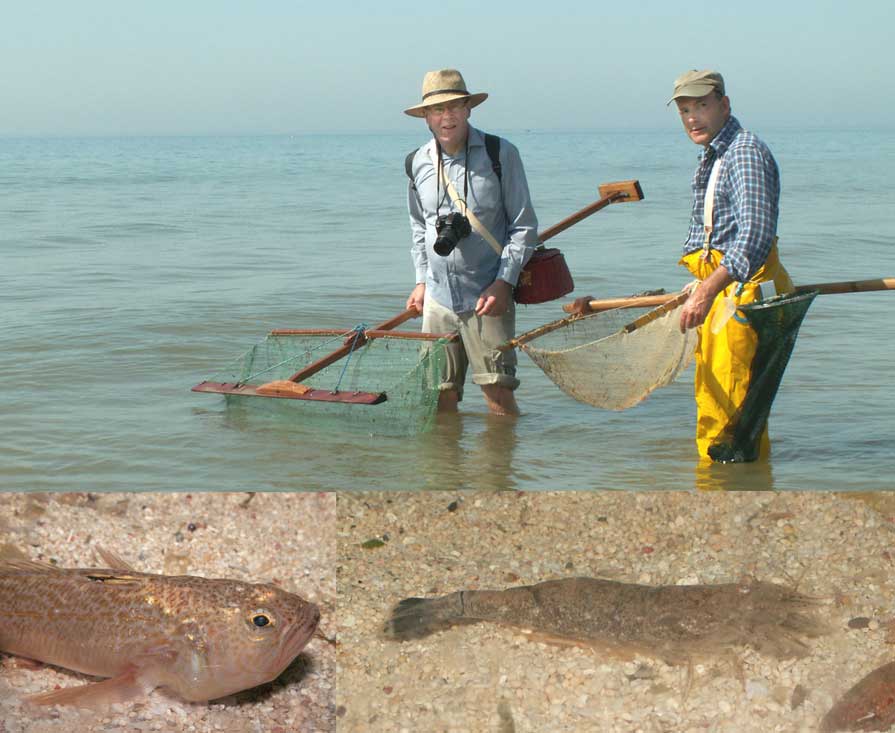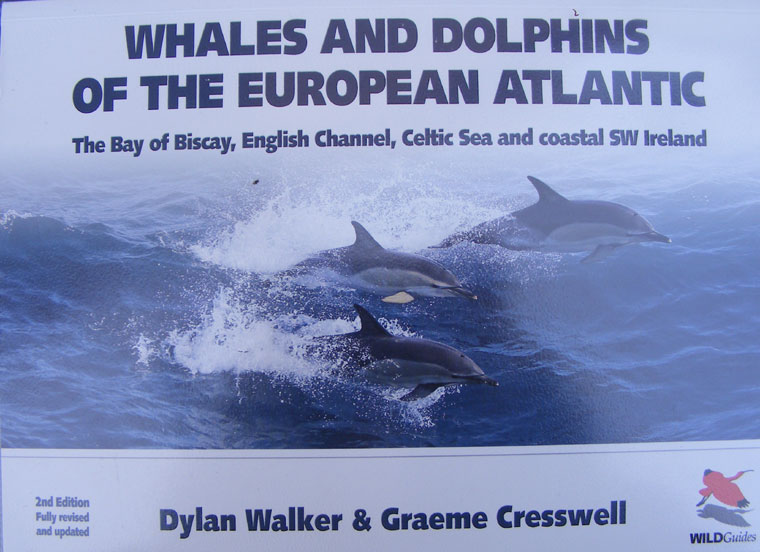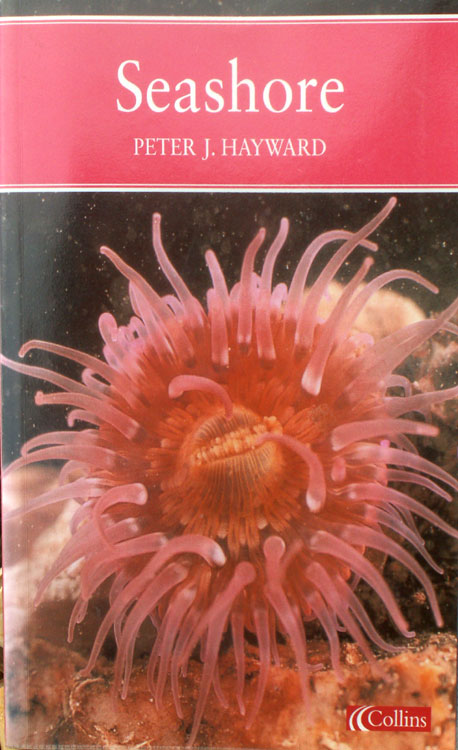PUBLICATIONS
&
WEB PAGES
-----------------------------------------------------------------------------------------------------------------------
BOOKS
PUBLICATIONS
June
2009
The
Edible
Seashore (River Cottage Handbook No. 5)
by
John
Wright is published
Not
just a cookery book: you have to go down to the shore and catch or collect
the food yourself. The 240 page hardback book (with an index) is exceptionally
well produced in quality of the binding, paper as well as the quality of
writing, information and clear useful colour photographs. It is well organised
into nine chapters:
Starting
Out: Conservation and Equipment, including the first paper published
instructions on how to construct a shrimp
net (push-net).
Foraging:
Lots of useful and essential information about the tides, weather, safety
and what to wear.
Rule
Book: This is the bravest inclusion. John
Wright attempts (better than anyone so far)
to explain the rules, law and ethics of seashore collection, what you are
allowed and not allowed to do. It is worth buying the book for this chapter
alone.
The
Flowering Plants
The
Seaweeds
 The
Molluscs The
Molluscs
The
Crustaceans
All
the expected species and some unlikely edible candidates are included and
each is given two pages. Very informative and lots of information I did
not already know. John Wright
conducted his research first hand and we shrimped
together on Southwick Beach with Peter Talbot-Elsden
(as shown in my photograph, not in the book).
The
Recipes: Well I would omit the chilli in the Potted
Shrimp. After collecting the food, I am usually
a wee bit tired and this chapter should be for your partner. Let me know
how you get on?
The
home-made shrimp
net on page 17 is an identical design to mine, the one used by John
Wright before he made his own on our expeditions
at Southwick, and the one used by Charlie
Dimmick on River Walks filmed on nearby Lancing
beach.
Conclusion:
Highly recommended, essential purchase ***** (highest five star rating).
BMLSS
Shrimping
-----------------------------------------------------------------
Up and Coming
TV:
The Seasons
presented
by Alan Titchmarsh
Tiger
Aspect and ITV1, due to be transmitted this Autumn
2010
’The
Seasons’ is a four-part series (no surprise there then!) that looks
at the way every living thing in Britain is profoundly affected by the
seasons. Its very much macrocosm to microcosm, starting with the astronomical
reasons for our seasons and then looking at the myriad and fascinating
effects they have. It investigates such basic factors as lengthening nights
and changes in temperature have in our islands.
The
very last piece of filming was the Blenny,
Lipophrys
pholis, with the help of myself (Andy
Horton). This small fish would not behave as the books said, because
the books were wrong!
Alan
Titchmarsh Blog
---------------------------------------------------------------------------------------------------------------------
Kimmeridge
Tidings
Autumn 2009
http://www.dorsetwildlifetrust.org.uk/c2/uploads/tidingsautumn09web.pdf
Up
to date with all the latest happenings at our Purbeck
Marine Wildlife Reserve in Kimmeridge.
VIVARIUM
by
Peter Stiles
Publisher:
Museum
of Barnstaple and North Devon
Philip
Henry Gosse was a popular naturalist who moved to Victorian Ilfracombe
and wrote his natural science book ‘A
Naturalist’s Rambles on the Devonshire Coast’. He later designed the
first public aquarium, which opened in London. His activities also attracted
other naturalists, including Charles Darwin and novelist George Eliot.
This
book celebrates the link between Philip Henry Gosse and his rockpool
adventures in Devon and contains lots of information about the life of
this self-taught Victorian scientist and writer.
in
conjunction with an Exhibition
that finished on 25 April 2009.
Marine
Fisheries Science Yearbook 2008/2009
Publisher:
defra
href="http://archive.defra.gov.uk/search/results.htm?cx=014361324438485032053%3Aljunwq2pe_y&cof=FORID%3A11&ie=UTF-8&q=Marine+Fisheries+Science+">To
obtain a copy from the defra web site, click on this text
 |
Sharks
in British Seas
Richard
Peirce
138
pages, colour illustrations, line drawings, colour & b/w photos.
Lots
of newspaper reports.
Publisher:
Shark Cornwall
Softcover
|
2008 | £9.99
ISBN:
978-0-955869402
|

Whales
& Dolphins
of
the European Atlantic
The
Bay of Biscay, English Channel, Celtic Sea and coastal SW Ireland
by
Dylan Walker and Graeme Cresswell
with
the illustrations by Robert Still
WILDGuides
2008
£
12.00 (includes standard UK P&P)
ISBN:
978-1-903657-31-7
This
is the second fully revised and updated edition of this comprehensive guide
to the identification of whales, dolphins and porpoises (collectively known
as cetaceans) in the European Atlantic. Until very recently, most researchers
and whale-watchers were unaware of the great variety of cetaceans that
can be seen so close to the shores of western Europe. Indeed, it is only
during the last decade, when detailed cetacean surveys have been carried
out in earnest, that we have discovered how important this area is for
cetacean biodiversity.
This
field guide describes all of the 31 species of whale, dolphin and porpoise
that have occurred in the European Atlantic.
BMLSS
Cetacean Book Reviews
The
Gulf Stream
by
Bruno Voituriez
Publisher:
UNESCO
ISBN:
92-3-103995-4
222
pages, figures, glossary, bibliography
The
Gulf Stream
Amid
contemporary scenarios of potential climatic catastrophes and global warming
that might be imagined to bring a new ice age, the powerful image of the
Gulf Stream rising from the Florida Straits and flowing to the north Atlantic
inevitably provokes questions about its ecological significance and whether
it might ever stop.
Coastal
Plankton
Photo Guide for
European Seas
by
Otto Larink & Wilfried Westheide
reviewed
by Wim van Egmond
 |
Seashore
(Collins
New Naturalist) (Paperback)
by
Peter Hayward
Collins
2004
ISBN:
0-00-220031-7
Amazon
Web Site |
Paperback.
Pp 288. Colour & b/w photographs, illustrations, charts, maps and bibliography.
Fine copy. "New Naturalist" Seashore is a comprehensive, authoritative
account of the natural history of the seashore.
BMLSS
General Guides
BMLSS
Advanced Guides
.
JOURNALS:
SAVE
OUR SEABIRDS NETWORK
Working
to reduce Marine Pollution and to help the birds caught in it
Quarterly
Newsletter
Registered
Charity 803473
--------------------------------------------------------------------------------------------------------------------
WEB
SITES
Decision-making
in Marine Mammal
Rescue
and Rehabilitation
Eastern
English Channel Habitat Atlas for Marine Resource Management
is
available for download from
http://charm.canterbury.ac.uk/atlas/pge.htm
Encyclopaedia
of Marine Life of Britain and Ireland
http://www.habitas.org.uk/marinelife/index.html?item=about
Marine
Fauna of Norway
http://www.seawater.no/fauna/e_index.htm

WET
THUMB (Marine Aquariology)
EFORUM
PAGE
BMLSS:
Marine Life Articles in Publications (Link)
|

